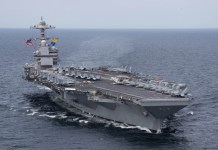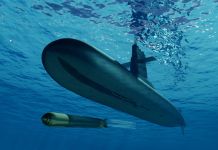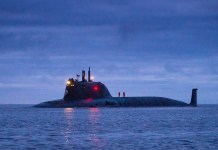Iran recently lifted its frigate IRIS Sahand from the bottom of the sea, nearly two weeks after it capsized and sank.
The ship sank completely in its home port of Bandar Abbas on July 7, 2024, after attempts to stabilize it were unsuccessful due to the breaking of the securing rope. The IRIS Sahand is one of Iran’s more recent indigenous frigates, modeled after the British-designed Vosper Mark 5.
However, its name, Sahand, carries a historical legacy for Iran. It echos an earlier frigate of the same name, which met a dramatic end at the hands of the US Navy in 1988.
The earlier IRIS Sahand, originally Faramarz (F-74), was deployed during the turbulent 1980s, known as the Tanker War, in the Persian Gulf.
The Tanker War emerged from the prolonged conflict between Iran and Iraq, spilling into the strategic waters of the Gulf and threatening global oil shipments. With a limited navy, Iraq turned to aerial assaults, whereas Iran utilized surface ships and strategically deployed mines.
Sahand and its sister ship Sabalan, both British-made Vosper Mark V class (also known as the Alvand class) frigates, gained notoriety for aggressive action against neutral shipping, contributing to the escalating tension.
At the time, the United States maintained a small naval presence in the Persian Gulf, known as the Middle East Force. This force did not interfere with the attacks on merchant ships, a stance that frustrated many American officers who viewed the Iranians as pirates or terrorists.
In late 1986, Kuwait requested protection for its tankers from Iranian attacks, turning to both the US and the Soviet Union for assistance. The US agreed to place Kuwait’s tankers under the American flag and provide escort services, initiating Operation Earnest Will.
The Operation Earnest Will program began in the summer of 1987, but the first escorted supertanker soon struck an Iranian mine. This incident, along with escalating Iranian threats of further mining, led to a low-level conflict between the United States and Iran that fall.
The United States military then expanded its operations in the Middle East by creating a special group called the Joint Task Force. At the same time, Iran continued to act aggressively, often harassing US forces in ways that almost triggered a full-scale conflict.
To address this, the US stationed Special Forces on floating bases in the region. These forces were tasked with preventing Iran from laying underwater mines and defending against attacks by small boats.
In the fall of 1987, several minor but crucial conflicts took place between US and Iranian forces. The US Navy sank an Iranian ship that was laying mines, and Navy SEALs fought with small boats from the Iranian Revolutionary Guard.
In retaliation, Iran launched a Silkworm missile at a US-flagged oil tanker, causing injuries to the captain. In response to this attack, the US destroyed an Iranian oil platform.
During the winter, escort operations by US forces went without major incidents. However, in the spring, Iran began laying mines again. On April 14, 1988, the US frigate Samuel B. Roberts (FFG-58) hit a mine. However, thanks to the heroic efforts of the crew in controlling the damage, the ship was saved from sinking.
The US Decided To Strike Iranians
The damage inflicted on the frigate Samuel B. Roberts (FFG-58) prompted a decisive response from the US military, which quickly formulated a plan for retaliation with three primary objectives.
The first two targets were Iranian oil platforms in the eastern Gulf, known as Sirri and Sassan, which served as command-and-control centers for attacks on tankers. The third objective was to sink an Iranian warship, ideally one of the notorious frigates.
Admiral William Crowe, Chairman of the Joint Chiefs of Staff, contacted Rear Admiral Anthony Less, the senior U.S. commander in the Gulf, and instructed him to target the Sabalan, a frigate deemed more dangerous than the IRIS Sahand.
Over a busy weekend of planning, US commanders established three Surface Action Groups (SAGs) – Bravo, Charlie, and Delta – each consisting of three naval ships.
Furthermore, Carrier Air Wing 11 from the aircraft carrier Enterprise (CVN-65), stationed just outside the Gulf, was tasked with providing air support. The operation, codenamed Operation Praying Mantis, commenced on April 18.
SAG Bravo, consisting of three naval ships—Merrill (DD-976), Lynde McCormick (DDG-8), and Trenton (LPD-14)—targeted the Sassan platform. After delivering a warning to evacuate, the group bombarded the platform using naval guns and Marine Cobra helicopters.
Simultaneously, SAG Charlie – consisting of the Wainwright (CG-28), Simpson (FFG-56), and Bagley (FF-1069) – attacked the Sirri platform, located east of Sassan.
Both platforms were soon ablaze. Marines managed to board and gather intelligence from the Sassan platform, but the Sirri platform was too damaged to permit boarding. The first phase of the operation was deemed a success.
Meanwhile, SAG Delta – comprising the Jack Williams (FFG-24), O’Brien (DD-975), and Joseph Strauss (DDG-16) – struggled to locate and sink an Iranian ship. Despite hours of patrolling the Strait of Hormuz, they had no luck finding the Sabalan or any other Iranian warship.
Meanwhile, the Iranian response was fragmented but bold. Smaller vessels and planes were dispatched, but the Sabalan remained moored at Bandar Abbas between two large tankers for protection.
However, that afternoon, the Sahand, a sister ship to the Sabalan, departed Bandar Abbas. Though less notorious than the Sabalan, the Sahand had a history of attacking merchant ships and appeared ready to retaliate.
US intelligence was aware of the Sahand’s sortie but uncertain of its identity. SAG Delta was advised to stay alert. Meanwhile, the Enterprise continued its air operations, with crews rotating to search for the Sabalan or another target.
Commander Arthur “Bud” Langston and his bombardier/navigator launched a reconnaissance mission in an A-6 Intruder, supported by an EA-6B Prowler and two F-14 escorts. The EA-6B reported a possible Iranian frigate moving in the Strait of Hormuz.
Langston’s A-6 aircraft spotted a frigate departing from the harbor at high speed. Despite the challenging visibility, Langston moved in for a closer look. He realized the potential international consequences of misidentification but deemed it necessary to confirm the target.
Langston’s A-6 descended near the frigate, and the ship opened fire, confirming its hostile status. The aircraft approached within 50 yards of the vessel to verify its identity, skillfully evading anti-aircraft guns and shoulder-fired weapons before retreating to a safer distance.
The Fate Of The Sahand: The Frigate’s Final Descent
Upon discovering the target, Langston quickly informed the Enterprise and requested the launch of the full strike group. Given the rules of engagement, which permitted immediate retaliation since the enemy had fired first, he proceeded to issue a warning.
Langston broadcast a radio message to the Iranian frigate that had fired on his A-6 Intruder, giving them a five-minute window to abandon ship before he initiated his attack.
At the Enterprise, Commander John Schork, head of Attack Squadron 95 (VA-95), received instructions to deploy the strike group, which consisted of seven aircraft: one A-6 Intruder and six A-7 Corsairs. As these planes scrambled to the target area, Langston waited the allotted five minutes before launching his solo offensive.
Langston’s assault began with a Harpoon missile that struck just behind the frigate’s bridge, billowing smoke and causing it to lose power. He then followed up with two Skipper bombs and additional laser-guided bombs, igniting multiple fires aboard the Sahand.
As the strike group reached its destination and launched its attack with Harpoon missiles, tensions escalated. Schork and his team were getting ready to launch their attack when they received instructions from USS Joseph Strauss (DDG-16) (a Charles F. Adams-class guided missile destroyer) to stand down as it was about to initiate its assault.

However, Schork decided to proceed with the attack. The Harpoons from the Schork and the Joseph Strauss hit the Sahand almost simultaneously, marking a key moment in the operation. This attack was later described as a “coordinated” effort between the surface ships and air support.
The once-feared frigate, known for its aggressive action against merchant vessels, was now under heavy assault. Though the ships of SAG Delta were too far away to visually confirm the attack, the crews were acutely aware of the situation.
On the other hand, Schork continued the offensive for a few additional minutes, targeting sections of the ship that had not yet been engulfed in flames. Observing that the crew had abandoned the vessel and was in life rafts, Schork decided to halt further attacks.
“As the senior officer in the cockpit, I assessed the damage and decided it was time to stop. We weren’t there to kill those who had already fled the ship,” he explained. With that, the strike group returned to the Enterprise, concluding their mission.
IRIS Sabalan (73): Under Siege
The US Navy halted its attack, and Iran dispatched boats to rescue the survivors of the Sahand, with US ships refraining from interference. The Sahand, engulfed in flames and thick black smoke, remained afloat but dead in the water for several hours before sinking later that night. Iran later reported 45 fatalities and 87 injuries from the incident.
Despite being outmatched, Iran finally launched the frigate Sabalan, a move that perplexed US intelligence officers. The USS Joseph Strauss (DDG-16) notified the attack aircraft of the Sabalan’s location.
Soon after, an A-6 attack bomber aircraft spotted the Iranian frigate and launched a laser-guided bomb that struck the Sabalan directly, leaving it severely damaged. The US Navy observed the Sabalan as it struggled to return to port, leaving a significant oil slick behind.

The US eventually decided to end the operation, deeming that enough damage had been done. Iran reported 29 injuries aboard the Sabalan but no fatalities.
The A-6s returned to the Enterprise after more than six hours of intense operation, with one US officer describing it as “the fastest six hours of my life.” Meanwhile, the damaged Sabalan was towed to Bandar Abbas, where it was eventually repaired and returned to service.
As the operation drew to a close, a US Navy Cobra helicopter investigating a surface contact reported evading a missile, only to later vanish from radar. Marine Captains Stephen Leslie and Kenneth Hill lost their lives in the incident, marking the only American casualties of the operation.
- Contact the author at ashishmichel(at)gmail.com
- Follow EurAsian Times on Google News




